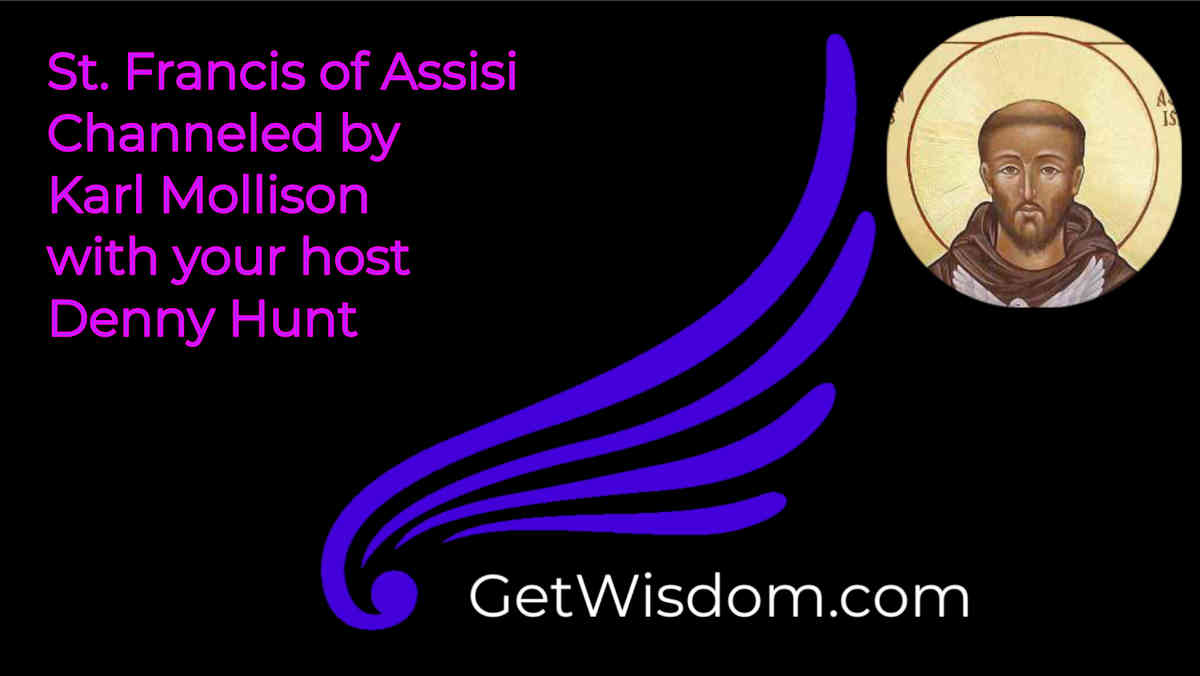
Saint Francis of Assisi Channeled by Karl Mollison 06Sept2020
From https://en.wikipedia.org/wiki/Francis_of_Assisi and
https://www.britannica.com/biography/Saint-Francis-of-
Assisi/The-Franciscan-rule
Francis of Assisi (Italian: San Francesco d’Assisi; Latin: Sanctus Franciscus Assisiensis), born Giovanni di Pietro di Bernardone, informally named as Francesco 1181/1182 – 3 October 1226 was an Italian Catholic friar, deacon, philosopher, mystic and preacher. He founded the men’s Order of Friars Minor, the women’s Order of Saint Clare, the Third Order of Saint Francis and the Custody of the Holy Land.
Francis is one of the most venerated religious figures in Christianity.
Francis renounced worldly goods and family ties to embrace a life of poverty. He repaired the church of San Damiano, refurbished a chapel dedicated to St. Peter the Apostle, and then restored the now-famous little chapel of St. Mary of the Angels (Santa Maria degli Angeli), the Porziuncola, on the plain below Assisi. There, on the feast of St. Matthias, February 24, 1208, he listened at mass to the account of the mission of Christ to the Apostles from the Gospel According to Matthew (10:7, 9–11): “And as you go, preach the message, ‘The kingdom is at hand!’…Take no gold, nor silver, nor money in your belts, no bag for your journey, nor two tunics, nor sandals, nor a staff; for the labourer deserves his food. And whatever town or villa you enter, find out who is worthy in it, and stay with him until you depart.” According to Thomas of Celano, this was the decisive moment for Francis, who declared, “This is what I wish; this is what I am seeking.This is what I want to do from the bottom of my heart.” He then removed his shoes, discarded his staff, put on a rough tunic, and began to preach repentance.
Pope Gregory IX canonized Francis on 16 July 1228. Along with Saint Catherine of Siena, he was designated Patron saint of Italy. He later became associated with patronage of animals and the natural environment, and it became customary for churches to hold ceremonies blessing animals on or near his feast day of 4 October. In the late spring of 1212, he set out for the Holy Land to preach to the Muslims but was shipwrecked on the east coast of the Adriatic Sea and had to return. A year or two later, sickness forced him to abandon a journey to the Muslims in Spain. In 1217 he proposed to go to France, but the future Pope Gregory IX, Cardinal Ugolino of Segni, an early and important supporter of the order, advised Francis that he was needed more in Italy.
In 1219 he did go to Egypt, where the crusaders were besieging Damietta. He went into the Muslim camp and preached to the sultan al-Kāmil, who was impressed by him and gave him permission (it is said) to visit the sacred places in the Holy Land. By this point, the Franciscan Order had grown to such an extent that its primitive organizational structure was no longer sufficient. He returned to Italy to organize the Order.
Once his community was authorized by the Pope, he withdrew increasingly from external affairs. Francis is also known for his love of the Eucharist. In 1223, Francis arranged for the first Christmas live nativity scene.
According to Christian tradition, in 1224 he received the stigmata during the apparition of Seraphic angels in a religious ecstasy, which would make him the second person in Christian tradition after St. Paul (Galatians 6:17) to bear the wounds of Christ’s Passion. He died during the evening hours of 3 October 1226, while listening to a reading he had requested of Psalm 142.
This humble friar chose poverty as his path to enlightenment. Does he still condone this approach from his position as a light being?
